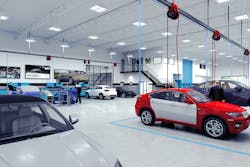Back in 1994, Ann Salazar joined a small consulting firm that opened her eyes to the possibility of working in the collision repair industry. Before long, she was aiding clients of major companies like BASF and Axalta on facility planning projects.
No matter the profile of the client, many shared a similar concern.
“I met a lot of people who wanted to improve their shop layout,” recalls Salazar, nearing her 20th year as owner of Avant Garde Interiors, which helps body shops that are seeking solutions for improved workflow. Those aforementioned clients “had a hard time finding someone with both a building design background, knowledge of the auto body repair process, and who knew the importance of efficient production flow.”
These days, Salazar, based out of Santa Clarita, Calif., helps shop operators utilize their space effectively, by taking steps like grouping similar work bays together to reduce the path of travel necessary for employees to retrieve shared tools.
Salazar is well aware of how dips in efficiency can damage a shop’s bottom line. Here’s her 10 tips for avoiding such inefficiency and shoring up shop floor constraints.
As told to Kelly Beaton
Observe a scaled layout of your facility.
A scaled plan is invaluable, where everything can be accurately displayed and moved around on paper. You can’t know for sure if something fits if you don’t see everything to scale.
Create a damage assessment area.
Some call it a triage, some call it a blueprinting area. Use of wireless equipment and software to document things helps reduce necessary motion and aid communication among coworkers. If possible, locate the damage assessment area by the exit door, front office, and the parts room.
Reduce the number of stalls per tech.
No work stall should become a parking space, where no employee is utilizing it.
Make use of cubic space.
Vertical walls, or even mezzanines, above work areas are often usable for employee break areas, or storage for fragile parts. Utilize wall racks, for example.
Rethink the location of frame machines.
Ideally, a frame machine should be near a hoist and in close proximity to your parts room. It should be easily accessible for rolling vehicles off a tow truck.
Utilize “dead” corner spaces.
This is especially helpful in L-shaped facilities. Determine which items you can store there to best take advantage of the often under-utilized space.
Analyze shop bottlenecks.
Look for work areas where a vehicle might be sitting idle, waiting for the next step in the production process. Ask what the cause is and address it. It might just be due to poor planning.
Consider new options in spray booths.
In an effort to speed up drying time, we now have booths that are side-loading. There are sideways-moving booths on overhead tracks. There are drying arches that can be installed to help bake the paint from inside out.
Reconfigure your shop floor.
Reconfigure the shop layout. Consider the location of office employees to improve collaboration without requiring foot traffic from one end of the building to the other. Keep shared tools in a centralized location.
Organize, organize, organize.
Get rid of items that aren’t necessary for the production process. Bottomline: if you haven’t used it in the past year or two, reassess and, most likely, dispose of it.

